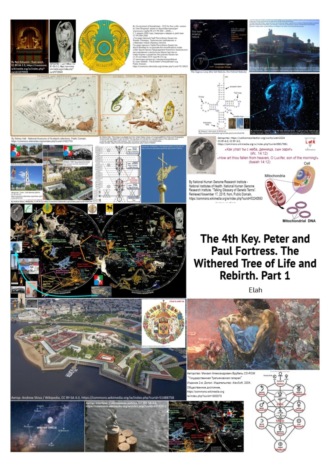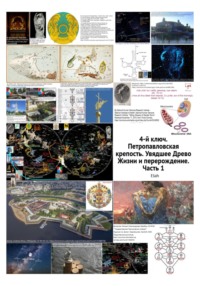
Полная версия
The 4th Key. Peter and Paul Fortress. The Withered Tree of Life and Rebirth. Part 1
6
In some plants, both ring and linear mitochondrial DNA molecules are present. Organisms such as infusoria from the protist group have only linear mitochondrial DNA. The genome of plant mitochondria can reach 370,000 nucleotide pairs, which is about 20 times larger than the genome of human mitochondria. The number of genes here is also about 7 times more, which is accompanied by the appearance of additional electronic transport pathways in plant mitochondria that are not associated with ATP synthesis. In plants, each mitochondria contains several DNA molecules of different sizes that are capable of recombination.
Human mitochondrial DNA encodes 2 ribosomal RNAs (rRNAs), 22 transport RNAs (tRNAs) and 13 proteins. These are redox proteins of the respiratory chain (Electron transport chain, ETC) of intracellular respiration carried out in mitochondria. The conjugated work of ETC and ATP synthase is called oxidative phosphorylation, which leads to the synthesis of ATP. The mitochondria produces less than half of the types of proteins it needs.
Mammalian and fungal mtDNA encodes very small ribosomes characterized by a sedimentation coefficient of 55S, which is even lower than that of the 70S-ribosomes of the prokaryotic type. At the same time, two large ribosomal RNAs are also smaller than in prokaryotes, and there is no small rRNA at all. In plant mitochondria, on the contrary, ribosomes are more similar to prokaryotic ones in size and structure.
The number of proteins translated from mitochondrial mRNA forming subunits of large enzyme complexes is limited. A significant part of proteins is encoded in the nucleus and synthesized on cytoplasmic 80S ribosomes.
The mitochondrial matrix also contains enzyme systems of organic oxidation and enzymes of the Krebs cycle. In general, the whole process of energy formation in mitochondria can be divided into four main stages, the first two of which take place in the matrix, and the last two – on the crystals of mitochondria. Source Wikipedia.
7
Depending on the level of their development, people differ from each other. From the "National Encyclopedia" of Kazakhstan:
"'Man' is a general concept that defines the features and differences of the human species from other biological species on Earth." (In this perspective, having a human body and not possessing something more, some special skills, differences that are worth preserving, is only a representative of one of the species of the animal world.)
"'Individual' is a single representative of the human race, an individual person. Individual is a set of personal, characteristic features that distinguish one person from another."
"'Personality' is not only the natural and biological characteristics of a person, it is what is outside of nature – the essence of a person living in society and formed in close connection with society. To be precise, personality is the human qualities of an individual outside of nature, qualities that represent significant aspects of his social life."
8
Modern man's sleep has two phases – slow and rapid, NREM and REM. Slow sleep has 4 stages. Western scientists have identified three stages. But, the natural cycle is a kind of unconscious dream and has 4 stages – spring, summer, autumn, winter. From this angle, it would be logical to divide the sleep phase into 4 parts:
1.1 NREM – Slow sleep, "dream time" and drowsiness (alpha rhythm (8-13Hz) decreases, theta rhythm appears (4-8 Hz)).
1.2 NREM – Slow sleep, shallow sleep (theta waves dominate, sleepy spindles appear, 2-5 times/min – sigma rhythm as rapid alpha (12-14–20 Hz) with the disconnection of human consciousness)
1.3 NREM – Slow sleep, deep sleep when it is difficult to wake a person (delta oscillations of 2 Hz <50%).
1.4 NREM – Slow sleep, deep sleep when it is difficult to wake a person (delta oscillations of 2 Hz >50%).
Rapid sleep (REM) does not occur immediately after slow sleep (NREM). After the last, 4th stage of slow sleep (NREM), there is a return to its 2nd stage, and then rapid sleep (REM) with elements of absurdity and paradox comes (see Wikipedia).
These elements draw our attention to the most important points, the key ones in the fractal formula for the unfolding of the scenario of the world.
1.5 Repeat NREM – Slow sleep, shallow sleep (theta waves dominate, sleepy spindles appear, 2-5 times/min – sigma rhythm as a rapid alpha (12-14–20 Hz) with the disconnection of human consciousness).
1.6 REM – REM sleep, the first stage, which is divided into two parts, corresponding to the "dream time" and the "drowsiness" NREM.
The second phase, REM – rapid sleep, consists of the same stages as slow sleep. But they proceed very quickly and are accompanied by rapid eye movements under closed eyelids. Therefore, the second phase is briefly called REM (Rapid Eye Movement), and the slow phase is called NREM (Not REM).
1.7-1.9 – REM – Rapid sleep, stages 2-4, corresponding to the same stages of slow sleep and the worlds of Assiya (performing actions), Yetzira (formation, formation of individuals), Briya (creation of personalities) in Kabbalah.
Apparently, the second part of the first stage of REM and its next three stages are directly related to the three and a half turns of consciousness development (see also the section "The Mobius loop, the fractal formula of the unfolding of the world and the structure of sleep" of the article "Behind the mirror – 3 …" and the post "Sleep, structure – phases, stages" in in the forum section "Collect meanings: Sleep, memory")
The REM phase correlates with the third Great Pyramid on the Giza plateau in Egypt – the pyramid of Menkaur (Mikerin) through… Hetaera Rhodopis, the prototype of Cinderella from a fairy tale (see the post "2 is NOT an endless story. All coincidences are thought out…" in the forum section "Collect meanings: Behind the mirror" on the website https://lichno-st.ru / project "Levels of Reality (Levels of Reality, LofR)







